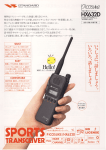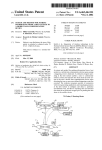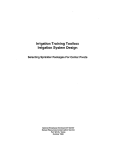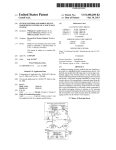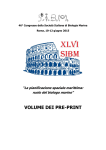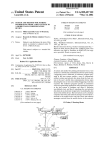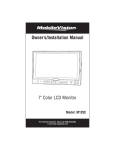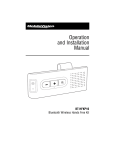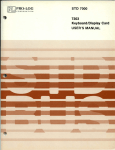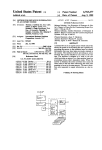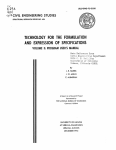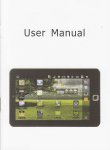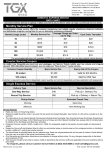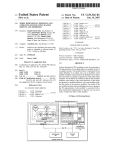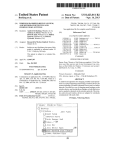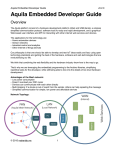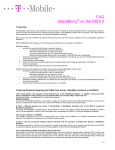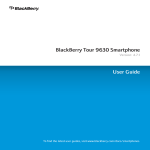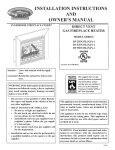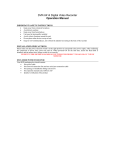Download System and method for pushing calendar event messages from a
Transcript
US006463463B1 (12) (54) (75) United States Patent (10) Patent N0.: Godfrey et al. (45) Date of Patent: Oct. 8, 2002 SYSTEM AND METHOD FOR PUSHING CALENDAR EVENT MESSAGES FROM A EP EP 0736989 0772327 10/1996 5/1997 HOST COMMUNICATION SYSTEM TO ADEVICE MOBILE DATA 5; EP 09214556 8/1997 Inventors: James Godfrey; Hugh R. Hind; Gary _ Mousseau; Mihal Lazaridis, all of _ (Llst Con?rmed on next page‘) W t 1 CA a er 0° ( ) (73) US 6,463,463 B1 OTHER PUBLICATIONS Assignee: Research In Motion Limited, Waterloo _ (CA) Mosher, The Microsoft Exchange User’s Handbook, 1997, Duke Communications, pp. 412—423.* ( * ) Notice? subject_to any disclaimeri the term of this Patent 15 extended or adlusted under 35 DaWson et al., RFC 2445, Internet Calendaring and Sched uling Core Object Speci?cation (iCalendar), from http:// U-S~C~ 154(k)) by 0 days- WWW.cis.ohiostate.edu/cgi—bin/rfc/rfc2445.html, pp. 1—130, Nov. 1998.* (21) Appl. N0.: 09/649,755 (22) Filed: (L'15I Con I'“me d on “X I Page). Aug. 28, 2000 Related US. Application Data Primary Examiner—Glenton B. Burgess Assistant Examiner—Bradley Edelman (74) Attorney, Agent, or Firm—]ones, Day, Reavis & Pogue; Krishna K. Pathiyal, Esq.; Charles B. Meyer, Esq. (63) Continuation-in-part of application No. O9/O87,623, ?led on May 29’ 1998’ now Pat' NO' 672197694 (51) (52) Int. Cl. .............................................. .. G06F 15/16 US. Cl. ......................... .. 709/206; 709/247; 705/9; 340/721; 340/729 A system and method for pushing information, such as (58) Field of Search ............................... .. 709/206, 247, calendar event messages, from a host system to a mobile 709/238; 340/729, 7.43, 7.51—7.57, 7.21; 705/9 data communication device upon sensing a triggering event is disclosed. A redirector program operating at the host 7 (57) ABSTRACT system enables a user to continuously redirect calendar (56) References Cited event messages, such as meeting reminders and notices, U'S' PATENT DOCUMENTS from the~host system to the user s mobile data communica tion device upon detecting that one or more user-de?ned 5,086,502 5,159,592 5,313,582 57392390 A A A A 2’41O’543 A ’416’473 A 2/ 1992 10/1992 5/1994 2/1995 Malcolm Perkins Hendel et alcrfmer triggering events has occurred. The redirector program oper ates in connection With event generating applications and repackaging systems at the host system to con?gure and detect a particular user-de?ned event, and then to repackage ‘Si/199g selltz et a1‘ / 199 1 the calendar event messages in an electronic Wrapper prior Du aney’ III et a ' to pushing the data items to the mobile device. An optimized (List continued on next page data structure for storing the calendar event messages is also rovided. p FOREIGN PATENT DOCUMENTS EP 0617373 9/1994 17 Claims, 10 Drawing Sheets I20 uoSI maox LUCA L AREA NETHD > 7 MEETING [LAN I- 2 J REQUEST a; t _ | [HAIL I T TH EICAL ATTACHMENT 120' US 6,463,463 B1 Page 2 US. PATENT DOCUMENTS 6,157,950 A 6,167,379 A 5436960 A 7/1995 CamPanaaJI- et 91- 5,438,611 A 5452356 A 5,479,472 A 8/1995 Campana, Jr. et al. 9/1995 Albert 12/1995 Campana, Jr. et al. 5,493,692 A * 5,495,484 A 5,559,800 A 2/1996 Theimeretal. ......... .. 455/26.1 2/1996 Self CI 8.1. 9/1996 Mousseau et al. 5572528 A 5,579,472 A 11/1996 Shuen 11/1996 Keyworth, 11 9t 91- 55887009 A 12/1996 12/2000 Krishman * 12/2000 4/2001 Martin ..................... .. 382/232 6,240,088 B1 6,249,820 B1 6,256,666 B1 5/2001 Gayton et al_ 6/2001 Dobbins etal. 7/2OO1 Singhal 6,272,545 B1 4 80001 6,275,848 B1 6,275,850 B1 8/2001 Arnold 8/2001 Beyda et al_ Will 6,363,352 B1 * 1/1997 Slaughter, III et 91- 576037054 A 2/1997 Theimer et 91- 2001/0001552 A1 * 5,625,670 5,627,829 576337810 5,641,946 4/1997 5/1997 5/1997 6/1997 A1 2001/0040693 A1 2001/0042093 A1 2001/0054072 A1 Campana, Jr. CI 8.1. 616650“ et 91Mandal ct a1~ campanaalr- 9t 91- 57666530 A 9/1997 Clark et 91- 5,666,553 5,673,322 5,727,202 5,729,735 5,737,531 5,742,905 5,751,971 9/1997 9/1997 3/1998 3/1998 4/1998 4/1998 5/1998 A A A A A A A 5,754,954 A 6,370,566 B2 * 2002/0010748 A1 * CroZier Pepe er 91Kiieala Meyering Ehley Pepe et al. Dobbins et al. Flanagin et a1_ __________ __ 709/228 6,327,046 B1 * 12/2001 Miyamoto et al. ....... .. 358/1.15 6,332,156 B1 * 12/2001 Cho et al. ....... .. 709/206 5598536 A A A A A Dean et al. .................. .. 705/9 6,222,942 B1 * 3/2002 Dailey et al. 5/2001 Vong et al. 10/2001 11/2001 11/2001 12/2001 . . . . . .. 705/9 709/206 . 340/691.1 Ohta Saito et al. Saito etal. Saito etal. 1/2002 Kobayashi et al. ....... .. 709/206 FOREIGN PATENT DOCUMENTS 5/1998 Cannon et al. EP EP EP 0793387 0825788 0838774 9/1997 2/1998 4/1998 EP EP 0838934 0772327 4/1998 2/1999 5,757,901 A 5/1998 Hiroshige EP 0930766 7/1999 5,761,416 5,765,170 5,781,901 5,790,790 A A A A 6/1998 6/1998 7/1998 8/1998 Mandal et al. Morikawa KuZma Smith et al. W0 W0 W0 W0 9619064 9726709 9727717 973341 6/1996 7/1997 7/1997 9/1997 5,790,974 5,812,819 5,813,016 5,819,172 5,819,284 5,822,434 5,826,062 5,838,926 5,850,219 5,867,660 5,878,434 5,903,723 5,928,329 A A A A A A A A A A A A A 8/1998 9/1998 9/1998 10/1998 10/1998 10/1998 10/1998 11/1998 12/1998 2/1999 3/1999 5/1999 7/1999 TognaZZini Rodwin et al. Sumimoto Campana, Jr. et al. Farber et al. Caronni et al. Fake, Jr. et al. Yamagishi Kumomura Schmidt et al. Draper et al. Beck et al. Clark et al. W0 W0 W0 W0 W0 W0 W0 W0 W0 W0 W0 9732251 9741654 9744942 9800787 9821911 9823108 9848560 9919988 9945484 9948312 9950974 9/1997 11/1997 11/1997 1/1998 5/1998 5/1998 10/1998 4/1999 9/1999 9/1999 10/1999 5,961,590 2 A . 10/1999 211222 Mendez etaa1_ ..... 4/2002 Discolo et al. ............ .. OTHER PUBLICATIONS .berkeley.edu/~iang/ecash/encoding, last updated May 17, 5,974,238 A 59787837 A 10/1999 Chase, Jr. 11/1999 Foladare ct a1~ 1990* “BlackBerry Technical White Paper,” Research In Motion 5,995,597 A 11/1999 WOlIZ'CI al. Ltd‘, Version 10, 1998_1999~ 2 Z: 2%: Newsletter, “Battery Friendly Bulletin,” vol. 1, Issue 3, pp. 6,014,429 A 1/2000 LaPorta et al. 1—7 and unnumbered Page, 1999 6,016,478 A * 1/2000 Zhang et al- ---------------- .- 705/9 Article, Cornerford, “Handhelds Duke It Out for the Inter 6923700 A 2/2000 Owens ct a1~ net,” Wireless Internet, pp. 35—38 and 41, Aug. 2000. 2 5232M 6ZO58Z431 A 6,078,921 A S/ZOOO Srisuresh et aL * Press Detail, “Extended Systems and Motorola Bring Shor t—Range Wireless to the Paglng E—volut1on,” Jan. 13, 2000 6/2000 Kelley ....................... .. 707/10 (3 1185-) 6,085,232 A 7/2000 Kikinis Press Detail, “3Com Corporation Licenses Bluetooth Tech 6JO91J951 A 7/2000 snlmiolo et 31- 2 Z: 2%: nology frorn Extended Systerns,” Feb. 22, 2000 (2 pgs.). Web site Article, HaWaleshka, “The Web in Your Pocket,” 6,101,531 A 8/2000 Eggleston et al. Made/“13> May 15> 2000 (3 PgS-) 6,115,394 A 6,115,736 A 9/2000 Balachandran et al. 9/2000 Devarakonda et al. ClaXton, “Messaging API’s for Voice Networks,” Telecorn rnunications, pp, 116—120, 1998. 9/2000 Wells et al. .............. .. 455/466 Egevang, K' et all‘, “The IP Network Address Translator,” 6,125,281 A * 6,130,892 A 10/2000 Short et al. . 6,134,432 A * 10/2000 Holmes et al. ........... .. 455/412 6,138,089 A * 10/2000 Guberman ................ .. 704/207 Network Workmg Group’ PP' 1_10>MaY 1994 Manual, “Server and BBS Software for the Packet Radio” by 6,141,690 A Jean Paul Roubelat, pp. 1—173. 10/2000 Weiman US 6,463,463 B1 Page 3 Book, “InternetWork Mobility The CDPD Approach,” by Mark S. Taylor, William Waung, and Mohsen Banan, Jun. 11, 1996. News Release, “Motorola Rings in 1995 With the Launch of the Marco® Wireless Communicator,” Jan. 4, 1995 (4 pgs.). Timeline, “FLEXTM Technology Timeline,” (3 pgs.). General Magic, Inc., Corporate Backgrounder, 2001 (2 pgS-)~ Pegasus Email Settings, ABSnet Internet Services, Inc. (4 pgS-)~ Johnson, David B., “Ubiquitous Mobile Host InternetWork ing,” Fourth Workshop on Workstation Operating Systems, pp. 85—90, Oct. 14—15, 1993. Johnson, David B., “Mobile Host InternetWorking Using IP Loose Source Routing,” School of Computer Science, Car negie Mellon University, pp. 1—14 Feb. 1993. Schoettle, Bob, “IP—Address Management on LANs,” Byte, pp. 199—200, Feb. 1996. Cheshire, Stuart, et al., “Internet Mobility 4x4,” Computer Science Department, Stanford University, pp. 1—12, Aug. Motorola, Inc., emailVClient, 2001 (4 pages). 1996. NeWs Release, “Motorola Announces PageWriter 250, The World’s Smallest Pager With Full Keyboard”, Feb. 27, 1997 Yeom, Hoen Y, et al., “IP Mutliplexing by Transparent Port—Address Translator,” Proceedings of the Tenth USENIX System Administration Conference, pp. 113—122, Sep. 29—Oct. 4, 1996. (2 PgS-) DeWey, Barney, “Communications Strategies for NeWton 2.0,” NeWton Technology Journal, p. 10, Jun. 1996. Press Release, “Motorola Announces NeW Solutions to Provide Consumers With Wireless Access to Personal and Enterprise E—mail Accounts,” Mar. 21, 2001 (4 pgs.). “Motorola’s ‘Marco’ Wireless Communication,” http://WW W.msu.edu/—luckie/gallery/marco.htm, Jun. 14, 2001 (3 pgS-)~ NeWs Release, “CE SoftWare Announces MobileVision,” Editorial Contacts, CE SoftWare, Inc., 1995 (3 pgs.). NeWs Release, “CE SoftWare Ship MobileVision,” Jun. 20, 1995 (3 pgs.). NeWton Reference, Communications, 1996—1997(4 pgs.). PC Pro Issue 31:RealWorld Computing, PDA Column, Jul. 30, 1997 (7 pgs.). Enterprise Solutions for Email Overload, Founder Publica tions, http:/WWW.amikanoW.com/corporte/publications.htm, Aug. 6, 2001 (9 pgs.). “Motorola’s ‘Marco’ Wireless Communicator,” http://WW W.msu.edu/—luckie/gallery/marco.htm, Aug. 6, 2001 (2 pgS-)~ Press Release, “Apple Agrees to License NeWton Technol ogy to Schlumberger, Digital Ocean,” Nov. 3, 1995 (3 pgs.). FreZZa, Bill, “PDA, PDA, Wherefore Art Thou, PDA?”, FreeWire, Aug. 6, 2001 (6 pgs.). Black, Lauren, et al., “Personal Digital Assistants,” Mac World RevieWs, Aug. 6, 2001 (5 pgs.). Reference, “MobileVision Direct Wireless Connection to Your LAN—Based Electronic Mailbox,” CE SoftWare, Inc., pp. 1, 3, 5, 7, 9, 11, 13, 15, 17, 19, 21, 1995. User Manual, “MobileVision Direct Wireless Connection to Your LAN—Based Electronic Mailbox,” CE SoftWare, Inc. 1995. Johnson, David B., “Scalable and Robust InternetWork Routing for Mobile Hosts,” IEEE Computer Society, pp. 2—11, 1994. Perkins, Charles, “IMHP: A Mobile Host Protocol for the Internet,” Computer NetWorks and ISDN System, vol. 27, pp. 479—491, 1994. Proceedings of the IEEE 7th International Workshop on NetWork and Operating System Support for Digital Audio and Video, Innsbrook Estates Conference Center, May 19—21, 1997, pp. 135—146. Lucent Technologies, Bell Labs Technical Journal, vol. 2, No. 3, pp. 152—163, Summer 1997. Lavana, Hemang, et al., Internet—Based Work?oWs: A Para digm for Dynamically Recon?gurable Desktop Environ ments, Group 97, pp. 204—213, 1997. Perkins, Charles E., et al., “Mobility Support in IPv6,” Mobicom 96, pp. 27—37, 1996. GoldsZmidt, German, et al., “ShockAbsorber: A TCP Con nection Router,” IEEE, vol. 3, pp. 1919—1923, 1997. Feibus, “A Desktop In Your Palm”, InformationWeek, Aug. 25, 1997, pp. 65ff. Behr, “Handheld Solutions”, InformationWeek, Oct. 27, 1997, pp. 106—113. Copy of DTS Wireless Website located at D.R.L. http:// WWW.dtsWireless.com. “3Com PalmPilot Gets Wireless Link for E—Mail”, Spooner, John G., PC Week, Dec. 8, 1997. “Have Your Pager Call My Pager”, Sullivan, Kristina B., PC Week, Dec. 8, 1997. * cited by examiner U.S. Patent US 6,463,463 B1 Sheet 1 0f 10 0a. 8,2002 DESKTOP LOCAL AREA NETHORK (LAN) , ~CIJMPUTER _Sl2 I r j-IO / K30 ~~ WIRELESS GATEWAY FAX 0R VOICE MACHINE U.S. Patent 0a. 8,2002 Sheet 2 0f 10 US 6,463,463 B1 A LOCAL AREA NE T (LANI II SERVER COMPUTER REDIRECTION SERVER/I sorlmgfne [30 FAX OR VOICE MACHINE WIRELESS GAIEHAY MOBILE COMPUTER U.S. Patent 0a. 8,2002 Sheet 3 0f 10 US 6,463,463 B1 LOCAL AREA NETIIORK [LAN] TCP/IP SUB-SYSTEM V PRIMARY STORE ALTERNATE L INK MAIN LINK I2 REOIRECTOR PROGRAM SETUP EVENTS TRIGGER 5 SETUP EVENTS TRIGGER 48 X f- 46 SCREEN SAVER SUB-SYSTEM KEYBOARD SUB-SYSTEM DESKTOP COMPUTER Fig, 3 U.S. Patent 0a. 8,2002 Sheet 4 0f 10 US 6,463,463 B1 ,— REDIRECTION SOFTWARE 5 50 STARTED INSTALL TRIGGER POINTS IN 52 I 60 SYSTEM /' < SET TRIGGER FIRED FLAG /' 54 MESSAGE AND SIGNALS ( S6 WAIT FOR YES —> MESSAGES AND N0 62 ESRSQEB YES @ ADD EUTER 570 ’ N0 ENVELOPE NEW E-MAlL ' MES§AGE OTHER EVENTS TO BE REDIR?ECTED 54 U.S. Patent 0a. 8,2002 Sheet 5 0f 10 f- 80 MOBILE SOFTWARE STARTED /' 84 US 6,463,463 B1 f- 88 EOHPOSE AND SEND TO DESKTOP MESSAGE AND %, “IT FOR ‘ MESSAGES AND t SET DESKTOP REDIREETION FLAG ON # f 106 SEND T0 N0 -- DESTINATION 100 15 USER usms DESKTOP ADDRESS PUT OUTER ENVELOPE ON MESSAGE AND ADDRESS TO DESKTOP ' Fig. 5 4 U.S. Patent 061. 8,2002 Sheet 6 6f 10 120 14 28 US 6,463,463 B1 26 HOST INBOX < LOCAL F j L AREA J . F j MEETING $12M L REuuEsT J . "'\,§ 1 SERVER U5 IE / ' REUIRECTOR SERVER EMACIILCAHLITH SOFTYARE ATTACHMENT ‘K 16- ,1’ MAY 2000 \ R’ g ; ‘\ \ I’;' M 7 a T M T r 5 [20B 1 92 l0a l14 I2s 136 j 21 H 22 15 2a I6 24 17 2s la 26 19 21 20 ‘<\ I8 s 2a 29 an 31 ‘\ I,’ L INTERNET NETWORK 24 32-4‘; l ’ ’ g 20 22 _ _ _ — - - --£- - - - _ — - -- U WIRELESS °°U°° GATEMAY PUA ‘40K, my . Flg- 7 COMMAND BYTE cum PARAMETER HEX VALUExlO my CALENDAR COMPONENTS [TYPE][[LENGTH]]<DATA> '46 NULL TERMINATOR Fig. 6 U.S. Patent Oct. 8,2002 Sheet 7 0f 10 US 6,463,463 B1 REDIRECTDR DETECTS NEH MESSAGE J '50 I56 I54 ' DETERMINE EMAIL /_ STANDARD REDIRECTIoN MESSAGE TYPE CREATE CICAL FILE ATTACHMENT ( '5 8 BASED DN MEETING DETAILS I ADD ATTACHMENT TD EMAIL SENT TO DEvICE, I '60 CDNTENT TYPE SET TO CALENDAR DATA FOR ATTACHMENT FI I uSER DPENS MEETING REDuEST AT DEvICE -/ 8 I62 I 'CALENDAR' CONTENT TYPE OF ATTACHMENT J ‘64 TRIGGERS CALENDAR APPLICATIDN "I CALENDAR APPLICATION DISPLAYS MEETING REDuEST DETAILS FOR USER \fl?? /- I70 I68 PROMPT TO ACCEPT STORE MEETING DETAILS FROM ATTACHMENT IN CALENDAR DATABASE ACCEPT/DECLINE I72 DISCARD MEETING DETAILS J DEVICE RESPONOS l BY SENDING CICAL ATTACHMENT I 176 REDIRECTOR IDENTIFIES MEETING REQUEST BASED ON AITACHMENT CONTENT TYPE I PROCESSES ATTACHMENT DATA, UPDATING CALENDAR STATuS AND CREATES RESPoNsE T0 oRGANIzER ‘78 f I /' I80 “EEml'? QEFT'O'SEEBGQPEARS U.S. Patent I82 Oct. 8, 2002 Sheet 8 0f 10 US 6,463,463 B1 USER CREATES MEETING IN DEVICE CALENDAR I MEETING DETAILS ENCOOES AS A CICAL FILE I I86 CICAL FILE ATTACHMENT ADDED TO 1 MAIL MESSAGE TO MEETING ATTENDEES I DEVICE SENDS EMAIL IIITH ATTACHMENT TO REDIRECTOR SOFTVARE I RECEIVES MESSAGE 190x RE DIRECTOR AND DETECTS ATTACHMENT (I94 STANDARD EMAIL HANDLING OPEN ATTACHMENT AND PROCESS CALENDAR DATA I CREATE MEETING ITEM IN USER'S HOST CALENDAR 200 I \’ SEND MEETING REQUEST TO ATTENDEES THROUGH HOST SYSTEM Fig. 9 U.S. Patent 0a. 8,2002 May I7 Messages Sheet 9 0f 10 112l- J Med, May 17, 2000 IE] 11:38 zzAlbert US 6,463,463 B1 300 test 3 I21 1l=30 zzALbert Accepted: Tes... J Il=28 reqAddr Test 7 I21 11:20 Don McCar... Re: Hellal! 121]]:20 Melinda He...Re: How are y... 81 ll:08 Melinda He...Re: How are y I21 l0:28 Dan McCar... Re: Hello!! I21 10:27 Tiln Tyhur... Re: not going i<_>i06:5l Hen Gaa Donuts in kitc... 12108149 803:]7 1208:48 ilardsnith Akas Dan McCar... Harv... A,Hord. Hellol! Tinbitsl! A. Day-800:10 alertQ OPEC: Venezue... Tue, May 16, 2000 |_<_>|2l:4l Selma Enns re comauter i<_>|17:47 Phil Nguyen Recurring Mult |<_>i 16:38 Tammy Ma... Reception area From: zzAlbert Hecht-Enns (Emailz? Subject: test 9 [l Attachnentlsllm When: Wednesday, May 17, 2000 PM-5:00 PM <BMT-05:00> Eastern Time <US & Canada] >. calendar <247> 312 4:30 } 310 U.S. Patent 0a. 8,2002 Sheet 10 0f 10 US 6,463,463 B1 Meet i ng Request Start: End: Hed. Ma y [7. 2000 Reminder: 16:38 l7:00 320 15 minutes Organizer: zzAlbert Hecht-Enns Invi ted: Albert Hecht-Enns Notes When: Wednesday, May 17, 2000 4:30 PM-SzOU PM (GMT-05:00) Eastern Time <US & Canada) >. Fig. 12 ¥~?t~ik~ik~ik~ik~~ilt~ik~ik~$k Meet i ng Request Hide Menu ' Start: 332 Wed. May 17. Accept End: Reminder: Organizer: Invi ted: Notes _ _/ ' Dec‘ ‘"8 zzAlbert Cancel Albert Hecht-Enns when: Wednesday, May 17, 2000 330 4:30 PM-5:00 PM (GMT-05:00) Eastern Time <US &: Canada] >. Fig. 13 US 6,463,463 B1 1 2 SYSTEM AND METHOD FOR PUSHING CALENDAR EVENT MESSAGES FROM A HOST SYSTEM TO A MOBILE DATA COMMUNICATION DEVICE only maintain the same data items after a user-initiated command sequence that causes the mobile device to doWn load the data items from the host system. A general problem With these “synchronization” systems is that the only time that the user data items are replicated betWeen the host system and the mobile data communication device is When the user commands the mobile device to doWnload or pull the user data from the host system. Five CROSS-REFERENCE TO RELATED APPLICATION This application is a continuation-in-part of US. patent application Ser. No. 09/087,623, titled “System and Method for Pushing Information from a Host System to a Mobile Data Communication Device,” ?led on May 29, 1998, now 10 US. Pat. No. 6,219,694. minutes later a neW message could be sent to the user, but the user Would not receive that message until the next time the user fetches the user data items. Thus, a user may fail to respond to an emergency update or message because the user only periodically synchronizes the system, such as once per day. BACKGROUND OF THE INVENTION 1. Field of the Invention The present invention is directed toWard the ?eld of replicating information from a host system Where the infor mation is normally stored to a mobile data communication 15 dif?culties, particularly When the mobile device is commu device. In particular, the system and method of the present invention provide an event-driven redirection computer pro nicating via a Wireless packet-sWitched netWork; and (2) reconciling large amounts of data, as can accrue in these gram (“redirector program”) operating at the host system, Which, upon sensing a particular user-de?ned event has occurred, redirects user-selected data items, such as calendar event messages, from the host system to the user’s mobile data communication device. The mobile data communica tion device is preferably coupled to the host system via a 25 Wireless netWork and one or more landline netWorks. Due to batch-mode synchronization systems, can require a great deal of communication betWeen the host and the mobile device, thus leading to a more complex, costly and energy inef?cient system. A more automated, continuous, ef?cient and reliable system of ensuring that user data items, such as calendar messages, are replicated at the user’s mobile device is therefore needed. the bandWidth limitations of Wireless netWorks, only a portion of a user-selected data item is generally redirected to the user’s mobile device, With the user given the option of then retrieving the entire data item (or some other portion of the data item) from the host system. Instead of Warehousing (or storing) the user’s data items at the host system and then “synchronizing” the mobile data Other problems With these systems include: (1) the amount of data to be reconciled betWeen the host and the mobile device can become large if the user does not “syn chronize” on a daily or hourly basis, leading to bandWidth Calendar event messages, such as meeting requests, are typically organized according to a particular calendar data structure. For example, RFC2445 (iCalendar), also referred 35 communication device to data items stored at the host system When the mobile device requests that such items of information be communicated to it, the present invention to as ICAL, provides such a structure and standard method for de?ning calendar-related data messages. When com bined With RFC2446 (iTIP), Which de?nes a transport independent means for exchanging ICAL objects, a mecha nism is provided to alloW calendar systems on multiple employs a “push” paradigm that continuously packages and platforms to inter-operate. retransmits the user-selected items of information to the mobile data communication device in response to a trigger ing event detected at the host system. Wireless mobile data communications devices, especially those that can return a ICAL uses verbose text strings and values to represent electronic calendar data. The RFC 2445 standard for struc turing ICAL messages does not make any attempt to reduce the size of the control information passed in the ICAL message. According to this knoWn calendar message standard, message size is not as important as is readability con?rmation signal to the host that the pushed data has been received are especially Well suited for this type of push paradigm. 45 from a host system to a user’s mobile data communication device are typically “synchronization” systems in Which the user’s data items are Warehoused (or stored) at the host system for an inde?nite period of time and then transmitted sending and receiving and structuring calendar event messages, such as meeting requests, to and from a portable in bulk only in response to a user request. In these types of data communication devices over a Wireless data netWork. systems and methods, When replication of the Warehoused data items to the mobile device is desired, the user typically places the mobile device in an interface cradle that is electrically connected to the host system via some form of of the message contents. The problem With using standards, such as ICAL, relates to sending calendar event messages over narroW bandWidth channels, like a Wireless packet data netWork. In such a netWork, it is critical to reduce the size of the message as much as possible. Therefore, there is a need for a system and method for 2. Description of the Related Art Present systems and methods for replicating information 55 Furthermore, there remains a general need in this art for a system and method of continuously pushing user-selected data items (or certain portions of the selected data items), such as calendar event messages, stored at a host system to a user’s mobile data communication device. There remains a more particular need for such a system local, dedicated communication, such as a serial cable or an infrared or other type of Wireless link. SoftWare executing on the mobile data communication device then transmits com mands via the local communications link to the host system to cause the host to begin transmitting the user’s data items for storage in a memory bank of the mobile device. In these and method Where user-selected data items are continuously “pushed” from the host system to the mobile data commu synchronization schemes, the mobile unit “pulls” the Ware de?ned triggering events. housed information from the host system in a batch each time the user desires to replicate information betWeen the tWo devices. Therefore, the tWo systems (host and mobile) nication device upon the occurrence of one or more user 65 There remains an additional need for such a system and method that provides ?exibility in the types and quantities of user data items that are pushed from the host system to the US 6,463,463 B1 3 4 mobile data communication device and that also provides ?exibility in the con?guration and types of events that can this invention that such con?guration may be set or modi?ed through data sent from the mobile communications device. serve to trigger the redirection of the user data items. There remains yet an additional need for such a system and method that can operate locally on a user’s desktop PC In addition to the functionality noted above, the redirector program provides a set of softWare-implemented control functions for determining the type of mobile data commu nication device and its address, for programming a preferred list of message types that are to be redirected, and for determining Whether the mobile device can receive and process certain types of message attachments, such as Word or at a distance via a netWork server. There remains still another need for such a system and method that provides for secure, transparent delivery of the user-selected data items from the host system to the mobile device. 10 processor or voice attachments. The determination of Whether a particular mobile device can receive and process 15 device at the host system. This con?guration can be altered on a global or per message basis by transmitting a command message from the mobile device to the host system. If the redirector is con?gured so that the mobile data device cannot receive and process Word processor or voice attachments, attachments is initially con?gured by the user of that mobile SUMMARY OF THE INVENTION The present invention overcomes the problems noted above and satis?es the needs in this ?eld for a system and method of pushing user-selected data items from a host system to a user’s mobile data communication device upon detecting the occurrence of one or more user-de?ned event then the redirector routes these attachments to an external triggers. As used in this application, the term host system machine that is compatible With the particular attachment, refers to the computer Where the redirector softWare is such as an attached printer or netWorked fax machine or operating. In the preferred embodiment of the present invention, the host system is a user’s desktop PC, although, telephone. Other types of attachments could be redirected to other types of external machines in a similar fashion, alternatively, the host system could be a netWork server connected to the user’s PC via a local-area netWork (“LAN) ”, or could be any other system that is in communication depending upon the capabilities of the mobile device. For example, if a user is traveling and receives a message With 25 an attachment that the user’s mobile device can process or With the user’s desktop PC. Aredirector program operating at the host system enables display, the user may from a mobile communications device send a command message to the host system indicating that that attachment is to be sent to a fax machine at a hotel Where the user Will be spending the evening. This enables the user to receive important E-mail attachments as long as the host the user to redirect or mirror certain user-selected data items (or parts of data items) from the host system to the user’s mobile data communication device upon detecting that one or more user-de?ned triggering events has occurred. Also system is provided With suf?cient information about the operating at the host system are various sub-systems that can be con?gured to create triggering events, such as a screen destination Where the attachment is to be forWarded. Once an event has triggered redirection of the user data items, the host system then repackages these items in a saver sub-system or a keyboard sub-system, as Well as sub-systems for repackaging the user’s data items for trans 35 parent delivery to the mobile data device, such as a TCP/IP sub-system or one or more E-Mail sub-systems. Other sub-systems for creating triggering events and repackaging manner that is transparent to the mobile data communication device, so that information on the mobile device appears similar to information on the user’s host system. The pre items for redirection, the user can then con?gure one or ferred repackaging method includes Wrapping the user data items in an E-mail envelope that corresponds to the address of the mobile data communication device, although, alternatively, other repackaging methods could be used With the present invention, such as special-purpose TCP/IP Wrap ping techniques, or other methods of Wrapping the user selected data items. The repackaging preferably results in E-mail messages generated by the user from the mobile device to be transmitted from the host system, thus enabling more event triggers to be sensed by the redirector program the user to appear to have a single E-mail address, such that the user’s data items could also be present at the host system. The host system also includes a primary memory store Where the user’s data items are normally stored. Using the redirector program, the user can select certain data items for redirection, such as E-mail messages, calendar events, meeting noti?cations, address entries, journal entries, personal reminders etc. Having selected the data 45 to initiate redirection of the user data items. These user the recipients of messages sent from the mobile communi de?ned trigger points (or event triggers) include external cations device do not knoW Where the user Was physically located When the message Was ?rst sent. The repackaging events, internal events and netWorked events. Examples of external events include: receiving a message from the user’s sensing that the user is no longer in the vicinity of the host also permits both messages to the mobile device and sent from the mobile device to be encrypted and decrypted as Well as compressed and decompressed. In an alternative system and method, the redirector pro system; or any other event that is external to the host system. 55 gram executes on a netWork server, and the server is Internal events could be a calendar alarm, screen saver activation, keyboard timeout, programmable timer, or any programmed to detect numerous redirection event triggers over the netWork from multiple user desktop computers other user-de?ned event that is internal to the host system. coupled to the server via a LAN. The server can receive NetWorked events are user-de?ned messages that are trans internal event triggers from each of the user desktops via the netWork, and can also receive external event triggers, such mobile data communication device to begin redirection; receiving a similar message from some external computer; mitted to the host system from another computer coupled to the host system via a netWork to initiate redirection. These are just some of the examples of the types of user-de?ned events that can trigger the redirector program to push data as messages from the users’ mobile data communication devices. In response to receiving one of these triggers, the server redirects the user’s data items to the proper mobile data communication device. The user data items and preferred embodiment it is anticipated that the con?guration 65 addressing information for a particular mobile device can be stored at the server or at the user’s PC. Using this alternative that speci?es Which data items Will be redirected and in What form Will be set at the host system, it is Within the scope of con?guration, one redirector program can serve a plurality items from the host to the mobile device. Although in the US 6,463,463 B1 5 6 of users. This alternative con?guration could also include an internet- or intranet-based redirector program that could be accessible through a secure Webpage or other user interface. The redirector program could be located on an Internet and real-time redirection of user-selected data items from a host system to a mobile data communication device. Other advantages of the present invention include: (1) ?exibility in de?ning the types of user data to redirect, and in de?ning a Service Provider’s system and accessible only through the preferred list of message types that are to be redirected or Internet. preferred senders Whose messages are to be redirected; (2) ?exibility in con?guring the system to respond to numerous In another alternative con?guration of the present internal, external and to netWorked triggering events; (3) invention, a redirector program operates at both the host system and at the user’s mobile data communication device. In this con?guration, the user’s mobile device operates similarly to the host system described beloW, and is con?g 10 ured in a similar fashion to push certain user-selected data items from the mobile device to the user’s host system (or some other computer) upon detecting an event trigger at the mobile device. This con?guration provides tWo-Way push transparent repackaging of the user data items in a variety of Ways such that the mobile data communication device appears as though it Were the host system; (4) integration With other host system components such as E-mail, TCP/IP, keyboard, screen saver, Webpages and certain programs that can either create user data items or be con?gured to provide 15 trigger points; and (5) the ability to operate locally on a ing of information from the host to the mobile device and from the mobile device to the host. Another aspect of the invention provides a neW data user’s desktop system or at a distance via a netWork server. structure for calendar events. The structure is based on a appreciated, the invention is capable of other and different embodiments, and its several details are capable of modi? cations in various respects, all Without departing from the These are just a feW of the many advantages of the present invention, as described in more detail beloW. As Will be standard calendar data structure, such as ICAL. HoWever, unlike the ICAL structure, Which utiliZes text strings that are spirit of the invention. Accordingly, the draWings and long and verbose, the present invention provides a com pressed data structure (referred to herein as “CICAL”) that uses numerical tags to represent the text strings. Because these numerical tags are much shorter in length then the long and verbose text strings in ICAL, the calendar event mes description of the preferred embodiments set forth beloW are to be regarded as illustrative in nature and not restrictive. 25 BRIEF DESCRIPTION OF THE DRAWINGS The present invention satis?es the needs noted above as sage can be effectively compressed, Which is particularly Will become apparent from the folloWing description When read in conjunction With the accompanying draWings useful When transferring calendar event messages over Wire less data netWorks. Another aspect of the invention provides a system for sending and receiving meeting requests on a portable data communication device. The system comprises: a host sys tem coupled to a host calendar, Wherein the host calendar stores calendar data records; a portable data communication device coupled to a device calendar, Wherein the device calendar stores calendar data records; a netWork coupling the host system to the portable data communication device; softWare operating at the host system for updating a calendar data record and for generating a meeting request that is transmitted to the device; and softWare operating at the portable data communication device for accepting and gen Wherein: FIG. 1 is a system diagram shoWing the redirection of user data items from a user’s desktop PC (host system) to the user’s mobile data communication device, Where the redi rector softWare is operating at the user’s desktop PC. 35 tem in FIG. 1 (the user’s desktop PC) to enable the pushing erating meeting requests. Another aspect of the invention provides a method for receiving meeting requests via a portable communication device. The method includes the steps of: 45 a meeting request arriving at the host, (ii) the host sending the meeting request to a redirector application, (iii) the redirector appli cation converting the meeting request into an e-mail With an attachment containing the meeting details, (iv) the redirector application sending to the device the e-mail With the attachment, (v) the device opening the attachment, (vi) the user of the device accepting or declining the meeting request, (vii) sending a response in an e-mail With an attachment containing the reply, and (viii) converting the of information from the host system to the user’s mobile data communication device. FIG. 4 is a How chart shoWing the steps carried out by the redirector softWare operating at the host system. FIG. 5 is a How chart shoWing the steps carried out by the mobile data communication device to interface With the redirector softWare operating at the host system. FIG. 6 is a diagram of a preferred system for sending and receiving calendar event messages, such as meeting requests, to and from a portable data communication device via a Wireless data netWork. FIG. 7 is a schematic of a preferred data structure for a 55 calendar event message according to an embodiment of the e-mail into a meeting response item and sending the meeting response item to the original sender of the meeting request. Another aspect of the invention provides a method for sending meeting requests from a portable data communica tion device comprising the steps of: creating a meeting request on the device, (ii) translating the meeting request to an e-mail With a CICAL attachment, (iii) sending the e-mail to the redirector, (iv) the redirector processing the CICAL present invention in Which meeting requests are sent from and received by a portable data communication device. FIG. 8 is a How chart shoWing the preferred method of receiving a meeting request at a portable data communica tion device sent from a host system. FIG. 9 is a How chart shoWing the preferred method of sending a meeting request from a portable data communi cation device to the host system. attachment, (v) sending the meeting request to the host, (vi) the host sending the meeting requests to the attendees. The primary advantage of the present invention is that it provides a system and method for triggering the continuous FIG. 2 is a system diagram shoWing the redirection of user data items from a netWork server (host system) to the user’s mobile data communication device, Where the redirector softWare is operating at the server. FIG. 3 is a block diagram shoWing the interaction of the redirector softWare With other components of the host sys 65 FIGS. 10—13 set forth a preferred set of graphical user interface screens for the portable data communication device shoWing the steps of receiving and accepting a meeting request US 6,463,463 B1 7 8 DETAILED DESCRIPTION OF THE DRAWINGS messaging capabilities, or a Wirelessly enabled laptop computer, but could, alternatively be other types of mobile data communication devices capable of sending and receiv Referring noW to the drawings, FIG. 1 is an example system diagram showing the redirection of user data items (such as message A or C) from a user’s of?ce PC (host system) 10 to the user’s mobile data communication device 24, Where the redirector softWare 12 is operating at the user’s PC. Message A in FIG. 1 represents an internal message sent from desktop 26 to the user’s host system 10 via LAN 14. Message C in FIG. 1 represents an external message from a sender that is not directly connected to LAN 14, such as the user’s mobile data communication device 24, some other user’s mobile device (not shoWn), or any user connected to the Internet 18. Message C also represents a command message from the user’s mobile data communi cation device 24 to the host system 10. As described in more ing messages via a netWork connection 22. Although it is preferable for the system to operate in a tWo-Way commu nications mode, certain aspects of the invention could be 10 bene?cially used in a “one and one-half” or acknoWledg ment paging environment, or even With a one-Way paging system. The mobile data communication device 24 includes softWare program instructions that Work in conjunction With the redirector program 12 to enable the seamless, transparent redirection of user-selected data items. FIG. 4 describes the basic method steps of the redirector program 12, and FIG. 5 describes the steps of the corresponding program operating 15 at the mobile device 24. In an alternative embodiment of the present invention, not detail in FIG. 3, the host system 10 preferably includes, along With the typical hardWare and softWare associated explicitly shoWn in the draWings, the mobile device 24 also With a Workstation or desktop computer, the redirector selected data items can be replicated from the host to the mobile device and vice versa. The con?guration and opera tion of the mobile device 24 having a redirector program is similar to that described herein With respect to FIGS. 1—4. A user of the present invention can con?gure the redirec tor program 12 to push certain user-selected data items to the user’s mobile data communication device 24 When the redirector 12 detects that a particular user-de?ned event includes a redirector program. In this embodiment, user program 12, a TCP/IP subsystem 42, a primary message store 40, an E-mail subsystem 44, a screen saver subsystem 48, and a keyboard subsystem 46. In FIG. 1, the host system 10 is the user’s desktop system, typically located in the user’s office. The host system 10 is connected to a LAN 14, Which also connects to other 25 computers 26, 28 that may be in the user’s of?ce or else Where. The LAN 14, in turn, is connected to a Wide area trigger (or trigger point) has taken place. User-selected data netWork (“WAN”) 18, preferably the Internet, Which is items preferably include E-mail messages, calendar events, de?ned by the use of the Transmission Control Protocol/ meeting noti?cations, address entries, journal entries, per Internet Protocol (“TCP/IP”) to exchange information, but Which, alternatively could be any other type of WAN. The sonal alerts, alarms, Warnings, stock quotes, neWs bulletins, etc., but could, alternatively, include any other type of connection of the LAN 14 to the WAN 18 is via high bandWidth link 16, typically a T1 or T3 connection. The WAN 18 in turn is connected to a variety of gateWays 20, via connections 32. A gateWay forms a connection or bridge betWeen the WAN 18 and some other type of netWork, such as an RF Wireless netWork, cellular netWork, satellite netWork, or other synchronous or asynchronous land-line connection. In the example of FIG. 1, a Wireless gateWay 20 is connected to the Internet for communicating via Wireless link 22 to a plurality of Wireless mobile data communication devices to 24. Also shoWn in FIG. 1 is machine 30, Which could be a FAX machine, a printer, a system for displaying images (such as video) or a machine capable of processing message that is transmitted to the host system 10, or that the host system 10 acquires through the use of intelligent agents, such as data that is received after the host system 10 initiates 35 a search of a database or a Website or a bulletin board. In some instances, only a portion of the data item is transmitted to the mobile device 24 in order to minimiZe the amount of data transmitted via the Wireless netWork 22. In these instances, the mobile device 24 can optionally send a command message to the host system to receive more or all of the data item if the user desires to receive it. 45 and playing audio ?les, such as a voice mail system. The present invention includes the ability to redirect certain Among the user-de?ned event triggers that can be detected by the redirector program 12 are in the preferred embodiment external events, internal events and netWorked events. External events preferably include: (1) receiving a command message (such as message C) from the user’s mobile data communication device to begin redirection, or message attachments to such an external machine 30 if the to execute some other command at the host, such as a redirector program con?guration data re?ects that the command to enable the preferred list mode, or to add or mobile device 24 cannot receive and process the attachments, or if the user has speci?ed that certain attach subtract a particular sender from the preferred list; (2) ments are not to be forWarded to mobile device 24, even if and (3) sensing that the user is no longer in the vicinity of the host system; although, alternatively, an external event receiving a similar message from some external computer; such device can process those attachments. By Way of example, consider an E-mail sent to a user that includes three attachments—a Word processing document, a video clip and an audio clip. The redirection program could be can be any other detectable occurrence that is external to the 55 screen saver activation, keyboard timeout, programmable con?gured to send the text of the E-mail to the remote device, to send the Word processing document to a net Worked printer located near the user, to send the video clip to a store accessible through a secure connection through the internet and to send the audio clip to the user’s voice mail system. This example is not intended to limit the breadth and scope of the invention, but rather to illustrate the variety of possibilities embodied in the redirection concept. The preferred mobile data communication device 24 is a hand-held tWo-Way Wireless paging computer, a Wirelessly enabled palm-top computer, a mobile telephone With data host system. Internal events could be a calendar alarm, timer, or any other user-de?ned event that is internal to the host system. NetWorked events are user-de?ned messages that are transmitted to the host system from another com puter coupled to the host system via a netWork to initiate redirection. These are just some of the events that could be 65 used With the present invention to initiate replication of the user-selected data items from the host system 10 to the mobile device 24. FIG. 1 shoWs an E-mail message Abeing communicated over LAN 14 from computer 26 to the user’s desktop system 10 (also shoWn in FIG. 1 is an external message C, Which US 6,463,463 B1 9 10 could be an E-mail message from an Internet user, or could message for redirection, the softWare 12 then sends the be a command message from the user’s mobile device 24). message A to a secondary memory store located in the mobile device 24, using Whatever means are necessary. In the preferred embodiment this method is to send the mes Once the message A (or C) reaches the primary message store of the host system 10, it can be detected and acted upon by the redirection softWare 12. The redirection softWare 12 sage A back over the LAN 14, WAN 18, and through the Wireless gateWay 20 to the mobile data communication can use many methods of detecting neW messages. The device 24. In doing so, the redirector preferably repackages preferred method of detecting neW messages is using Microsoft’s® Messaging API (MAPI), in Which programs, such as the redirector program 12, register for noti?cations or ‘advise syncs’ When changes to a mailboX take place. Other methods of detecting neW messages could also be used With the present invention. message A as an E-mail With an outer envelope B that contains the addressing information of the mobile device 24, 10 con?guration shoWn in FIG. 2). The Wireless gateWay 20 Assuming that the redirector program 12 is activated, and has been con?gured by the user (either through the sensing of an internal, netWork or eXternal event) to replicate certain user data items (including messages of type A or C) to the mobile device 24, When the message Ais received at the host system 10, the redirector program 12 detects its presence and prepares the message for redirection to the mobile device 24. In preparing the message for redirection, the redirector program 12 could compress the original message A, could compress the message header, or could encrypt the entire requires this outer envelope information B in order to knoW 15 in the secondary memory store Within the mobile device 24. By repackaging and removing the outer envelope in this manner, the present invention causes the mobile computer 24 to appear to be at the same physical location as the host system 10, thus creating a transparent system. In the case Where message C is representative of an external message from a computer on the Internet 18 to the 25 host system 10, and the host 10 has been con?gured to redirect messages of type C, then in a similar manner to message A, message C Would be repackaged With an outer envelope B and transmitted to the user’s mobile device 24. In the case Where message C is representative of a command message from the user’s mobile device 24 to the host system 10, the command message C is not redirected, but is acted programmed to route the attachments to a faX or voice number Where the user is located using an attached faX or voice machine 30. The redirector may also be programmed With a preferred list mode that is con?gured by the user either at the host system 10, or remotely from the user’s mobile data com munication device by transmitting a command message C. Where to send the redirected message A. Once the message (A in B) is received by the mobile device 24, the outer envelope B is removed and the original message Ais placed message A to create a secure link to the mobile device 24. Also programmed into the redirector 12 is the address of the user’s mobile data communication device 24, the type of device, and Whether the device 24 can accept certain types of attachments, such as Word processing or voice attach ments. If the user’s type of mobile device cannot accept these types of attachments, then the redirector 12 can be although alternative repackaging techniques and protocols could be used, such as a TCP/IP repackaging and delivery method (most commonly used in the alternative server upon by the host system 10. If the redirected user data item is an E-mail message, as described above, the user at the mobile device 24 sees the 35 original subject, sender’s address, destination address, car bon copy and blind carbon copy. When the user replies to The preferred list contains a list of senders (other users) this message, or When the user authors a neW message, the Whose messages are to be redirected or a list of message softWare operating at the mobile device 24 adds a similar characteristics that determine Whether a message is to be outer envelope to the reply message (or the neW message) to redirected. If activated, the preferred list mode causes the redirector program 12 to operate like a ?lter, only redirecting cause the message to be routed ?rst to the user’s host system 10, Which then removes the outer envelope and redirects the message to the ?nal destination, such as back to computer certain user data items based on Whether the data item Was sent from a sender on the preferred list or has certain message characteristics that if present Will trigger or sup press redirection of the message. In the eXample of FIG. 1, if desktop system 26 Was operated by a user on the preferred 45 26. In the preferred embodiment, this results in the outgoing redirected message from the user’s host system 10 being sent using the E-mail address of the host mailboX, rather than the address of the mobile device, so that it appears to list of host system 10, and the preferred list option Was activated, then message AWould be redirected. If, hoWever, the recipient of the message that the message originated from the user’s desktop system 10 rather than the mobile data communication device. Any replies to the redirected message Will then be sent to the desktop system 10, Which if it is still in redirector mode, Will repackage the reply and desktop 26 Was operated by a user not on the host system’s preferred list, then message AWould not be redirected, even if the user of the host system had con?gured the redirector to push messages of type A. The user of the host system 10 resend it to the user’s mobile data device, as described above. can con?gure the preferred list directly from the desktop system, or, alternatively, the user can then send a command FIG. 2 is an alternative system diagram shoWing the message (such as C) from the mobile device 24 to the desktop system 10 to activate the preferred list mode, or to 55 redirection of user data items from a netWork server 11 to the user’s mobile data communication device 24, Where the redirector softWare 12 is operating at the server 11. This con?guration is particularly advantageous for use With mes add or delete certain senders or message characteristics from the preferred list that Was previously con?gured. It should be appreciated that a redirection program could combine mes sage characteristics and preferred sender lists to result in a more ?nely-tuned ?lter. Messages marked as loW priority or that are simple return receipts or message read receipts, for sage servers such as Microsoft’s® Exchange Server, Which is normally operated so that all user messages are kept in one eXample, could alWays be suppressed from redirection While the additional advantage of alloWing a single system admin istrator to con?gure and keep track of all users having messages redirected. If the system includes encryption keys, messages from a particular sender Would alWays be redi rected. After the redirector has determined that a particular message should be redirected, and it has prepared the central location or mailboX store on the server instead of in a store Within each user’s desktop PC. This con?guration has 65 these too can be kept at one place for management and update purposes. US 6,463,463 B1 11 12 In this alternative con?guration, server 11 preferably maintains a user pro?le for each user’s desktop system 10, 26, 28, including information such as Whether a particular parency of the present invention, and the screen saver and keyboard sub-systems 46, 48 are examples of event gener ating systems that can be con?gured to generate event user can have data items redirected, Which types of message messages or signals that trigger redirection of the user selected data items. The method steps carried out by the redirector program 12 and information to redirect, What events Will trigger redirection, the address of the users’ mobile data commu nication device 24, the type of mobile device, and the user’s preferred list, if any. The event triggers are preferably detected at the user’s desktop system 10, 26, 28 and can be are described in more detail in FIG. 4. The basic functions of this program are: (1) con?gure and setup the user-de?ned event trigger points that Will start redirection; (2) con?gure any of the external, internal or netWork events listed above. the types of user data items for redirection and optionally con?gure a preferred list of senders Whose messages are to The desktop systems 10, 26, 28 preferably detect these events and then transmit a message to the server computer be redirected; (3) con?gure the type and capabilities of the 11 via LAN 14 to initiate redirection. Although the user data items are preferably stored at the server computer 11 in this embodiment, they could, alternatively, be stored at each user’s desktop system 10, 26, 28, Which Would then transmit user’s mobile data communication device; (4) receive mes 15 redirection of the user-selected data items to the mobile data them to the server computer 11 after an event has triggered communication device via the repackaging systems. Other functions not speci?cally enumerated could also be inte grated into this program. The E-Mail sub-system 44 is the preferred link to repack aging the user-selected data items for transmission to the mobile data communication device 24, and preferably uses industry standard mail protocols, such as SMTP, POP, redirection. As shoWn in FIG. 2, desktop system 26 generates a message Athat is transmitted to and stored at the host system 11, Which is the netWork server operating the redirector program 12. The message Ais for desktop system 10, but in this embodiment, user messages are stored at the netWork server 11. When an event occurs at desktop system 10, an event trigger is generated and transmitted to the netWork server 11, Which then determines Who the trigger is from, Whether that desktop has redirection capabilities, and if so, the server (operating the redirector program) uses the stored con?guration information to redirect message A to the mobile computer 24 associated With the user of desktop system 10. As described above With reference to FIG. 1, message C sages and signals from the repackaging systems and the event generating systems; and (5) command and control the 25 IMAP, MIME and RFC-822, to name but a feW. The E-Mail sub-system 44 can receive messages A from external com puters on the LAN 14, or can receive messages C from some external netWork such as the Internet 18 or a Wireless data communication netWork 22, and stores these messages in the primary data store 40. Assuming that the redirector 12 has been triggered to redirect messages of this type, the redi rector detects the presence of any neW messages and instructs the E-Mail system 44 to repackage the message by placing an outer Wrapper B about the original message A (or could be either a command message from a user’s mobile data communication device 24, or it could be a message from an external computer, such as a computer connected to 35 C), and by providing the addressing information of the mobile data communication device 24 on the outer Wrapper the Internet 18. If the message C is from an Internet B. As noted above, this outer Wrapper B is removed by the computer to the user’s desktop system 10, and the user has mobile device 24, and the original message A (or C) is then redirection capabilities, then the server 11 detects the mes recovered, thus making the mobile device 24 appear to be sage C, repackages it using electronic envelope B, and redirects the repackaged message (C in B) to the user’s the desktop system 10. mobile device 24. If the message C is a command message In addition, the E-Mail sub-system 44 receives messages from the user’s mobile device 24, then the server 11 simply back from the mobile device 24 having an outer Wrapper acts upon the command message. With the addressing information of the desktop system 10, Turning noW to FIG. 3, a block diagram shoWing the interaction of the redirector softWare 12 With additional and strips this information aWay so that the message can be 45 components of the host system 10 of FIG. 1 (the desktop PC) routed to the proper sender of the original message A(or C). The E-Mail sub-system also receives command messages C from the mobile device 24 that are directed to the desktop to enable more fully the pushing of information from the host system 10 to the user’s mobile data communication device 24 is set forth. These additional components are illustrative of the type of event-generating systems that can be con?gured and used With the redirector softWare 12, and of the type of repackaging systems that can be used to interface With the mobile communication device 24 to make function. The functionality of the E-Mail sub-system 44 is controlled by the redirector program 12. The TCP/IP sub-system 42 is an alternative repackaging system. It includes all of the functionality of the E-Mail it appear transparent to the user. data items as standard E-mail messages, this system repack The desktop system 10 is connected to LAN 14, and can system 10 to trigger redirection or to carry out some other sub-system 44, but instead of repackaging the user-selected 55 send and receive data, messages, signals, event triggers, etc., to and from other systems connected to the LAN 14 and to external netWorks 18, 22, such as the Internet or a Wireless data netWork, Which are also coupled to the LAN 14. In addition to the standard hardWare, operating system, and application programs associated With a typical microcom puter or Workstation, the desktop system 10 includes the redirector program 12, a TCP/IP sub-system 42, an E-mail sub-system 44, a primary data storage device 40, a screen saver sub-system 48, and a keyboard sub-system 46. The TCP/IP and E-mail subsystems 42, 44 are examples of repackaging systems that can be used to achieve the trans ages the data items using special-purpose TCP/IP packaging techniques. This type of special-purpose sub-system is use ful in situations Where security and improved speed are important to the user. The provision of a special-purpose Wrapper that can only be removed by special softWare on the mobile device 24 provides the added security, and the bypassing of E-mail store and forWard systems can improve speed and real-time delivery. 65 As described previously, the present invention can be triggered to begin redirection upon detecting numerous external, internal and netWorked events, or trigger points. Examples of external events include: receiving a command message from the user’s mobile data communication device US 6,463,463 B1 13 14 24 to begin redirection; receiving a similar message from an event trigger. When a message or signal is detected, the program determines 58 Whether it is one of the trigger events some external computer; sensing that the user is no longer in the vicinity of the host system; or any other event that is external to the host system. Internal events could be a that has been con?gured by the user to signal redirection. If so, then at step 60 a trigger ?ag is set, indicating that subsequently received user data items (in the form of messages) that have been selected for redirection should be pushed to the user’s mobile data communication device 24. calendar alarm, screen saver activation, keyboard timeout, programmable timer, or any other user-de?ned event that is internal to the host system. Networked events are user de?ned messages that are transmitted to the host system from another computer that is connected to the host system via a netWork to initiate redirection. 10 The screen saver and keyboard sub-systems 46, 48 are examples of systems that are capable of generating internal events. Functionally, the redirector program 12 provides the If the program message message message or signal 54 is not a trigger event, the then determines at steps 62, 68 and 66 Whether the is, respectively, a system alarm 62, an E-Mail 64, or some other type of information that has been selected for redirection. If the message or signal is none of rector 12 to start the redirection process. For example, the these three items, then control returns to step 56, Where the redirector Waits for additional messages 54 to act upon. If, hoWever the message is one of these three types of information, then the program 12 determines, at step 68, Whether the trigger ?ag has been set, indicating that the user screen saver system can be con?gured so that When the Wants these items redirected to the mobile device. If the screen saver is activated, after, for example, 10 minutes of inactivity on the desktop system, an event trigger is trans mitted to the redirector 12, Which starts redirecting the trigger ?ag is set, then at step 70, the redirector 12 causes the repackaging system (E-Mail or TCP/IP) to add the outer envelope to the user data item, and at step 72 the repackaged previously selected user data items. In a similar manner the data item is then redirected to the user’s mobile data keyboard sub-system can be con?gured to generate event triggers When no key has been depressed for a particular period of time, thus indicating that redirection should com gateWay 20 and Wireless netWork 22. Control then returns to step 56 Where the program Waits for additional messages and user With the ability to con?gure the screen saver and keyboard systems so that under certain conditions an event 15 trigger Will be generated that can be detected by the redi communication device 24 via LAN 14, WAN 18, Wireless 25 mence. These are just tWo examples of the numerous appli cation programs and hardWare systems internal to the host system 10 that can be used to generate internal event signals to act upon. Although not shoWn explicitly in FIG. 4, after step 68, the program could, if operating in the preferred list mode, determine Whether the sender of a particular data item is on the preferred list, and if not, then the program Would skip over steps 70 and 72 and proceed directly back triggers. FIGS. 4 and 5, set forth, respectively, ?oW charts shoWing the steps carried out by the redirector softWare 12 operating at the host system 10, and the steps carried out by the mobile to step 56. If the sender Was on the preferred list, then control Would similarly pass to steps 70 and 72 for repackaging and transmission of the message from the preferred list sender. FIG. 5 sets forth the method steps carried out by the user’s data communication device 24 in order to interface With the host system. Turning ?rst to FIG. 4, at step 50, the redirector program 12 is started and initially con?gured. The initial con?guration of the redirector 12 includes: (1) de?ning the event triggers that the user has determined Will trigger redirection; (2) selecting the user data items for redirection; 35 mobile data communication device 24 in order to interface to the redirector program 12 of the present invention. At step 80 the mobile softWare is started and the mobile device 24 is con?gured to operate With the system of the present (3) selecting the repackaging sub-system, either standard E-Mail, or special-purpose technique; (4) selecting the type invention, including, for example, storing the address of the user’s desktop system 10. of data communication device, indicating Whether and What type of attachments the device is capable of receiving and processing, and inputting the address of the mobile device; and (5) con?guring the preferred list of user selected senders At step 82, the mobile device Waits for messages and signals 84 to be generated or received. Assuming that the redirector softWare 12 operating at the user’s desktop system 10 is con?gured to redirect upon receiving a message from Whose messages are to be redirected. 45 FIG. 4 sets forth the basic steps of the redirector program 12 assuming it is operating at a desktop system 10, such as shoWn in FIG. 1. If the redirector 12 is operating at a netWork server 11, as shoWn in FIG. 2, then additional con?guration steps may be necessary to enable redirection composed and sent to the desktop system 10 via the Wireless netWork 22, through the Wireless gateWay 20, via the Inter net 18 to the LAN 14, and is ?nally routed to the desktop machine 10. In this situation Where the mobile device 24 is sending a message directly to the desktop system 10, no for a particular desktop system 10, 26, 28 connected to the server, including: (1) setting up a pro?le for the desktop system indicating its address, events that Will trigger redirection, and the data items that are to be redirected upon detecting an event; (2) maintaining a storage area at the the user’s mobile device 24, at step 86, the user can decide to generate a command message that Will start redirection. If the user does so, then at step 88 the redirection message is outer Wrapper is added to the message (such as message C 55 server for the data items; and (3) storing the type of data communication device to Which the desktop system’s data in FIGS. 1 and 2). In addition to the redirection signal, the mobile device 24 could transmit any number of other commands to control the operation of the host system, and in particular the redirector program 12. For example, the items are to be redirected, Whether and What type of attach mobile 24 could transmit a command to put the host system ments the device is capable of receiving and processing, and into the preferred list mode, and then could transmit addi the address of the mobile device. tional commands to add or subtract certain senders from the preferred list. In this manner, the mobile device 24 can Once the redirector program is con?gured 50, the trigger points (or event triggers) are enabled at step 52. The program 12 then Waits 56 for messages and signals 54 to begin the redirection process. A message could be an E-Mail message or some other user data item than may have been selected for 65 dynamically limit the amount of information being redi rected to it by minimiZing the number of senders on the preferred list. Other example commands include: (1) a message to change the con?guration of the host system to redirection, and a signal could be a trigger signal, or could be some other type of signal that has not been con?gured as enable the mobile device 24 to receive and process certain attachments; and (2) a message to instruct the host system to


























